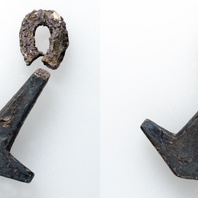
Viking Objects
Thor’s Hammer Pendant (1989-59/7224)
A silver hammer-shaped pendant found in Grave 511 at Repton. This is the grave of a man who appears to have died violently, taking a vicious cut to his loins. These may have been worn to show devotion to the god Thor, or to secure the god’s protection, although there is little evidence to support this interpretation. Pendants like this have been found made of lead, copper alloy, silver and gold, showing that many different strata of society could have worn them.
Read More
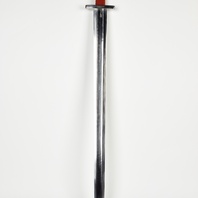
Viking Objects
Reproduction Viking Age Sword
A reproduction of the sword found in Grave 511 at Repton. The hilt is made of wood laths wrapped in tabby weave textile strips. The scabbard is made of two wooden laths, lined with trimmed sheep fleece, and covered in an oak-stained, stitched, calf-leather cover. The strap slide is copper alloy and inserted under the leather. The sword belt shown with the scabbard is based on the sword belt from Grave 511 at Repton.
Read More
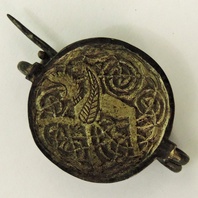
Viking Objects
Silver Gilt Brooch (1989-58/7224)
A circular silver gilt plate brooch with chip carved decoration of a winged creature. The creature may be a griffin. It is enmeshed in fine spiralling interlace. The reverse features a U-shaped catchplate and pin with a spring. This decoration is Mercian in style. For more information on Scandinavian jewellery in England check out our blog: Brooches, Pendants and Pins: Scandinavian Dress Accessories in England.
Read More
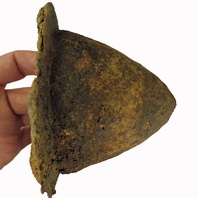
Viking Objects
Shield Boss (1989-59/9013)
This is a probable Viking shield boss from Repton, Derbyshire. This shield boss is possible evidence for the Viking Great Army’s overwintering at Repton in 873. The typical construction of a ‘Viking’ shield at the time involved several wooden planks glued together and cut into a circle. The face of the shield was then covered in linen or rawhide with rawhide edging that was either tacked or sewn on. Finally, a metal boss would be attached along with the handle over a hole in the centre. The purpose of the metal boss was to protect the user’s hand in combat.
Read More
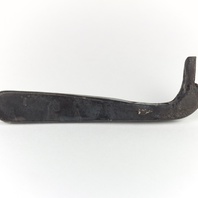
Viking Objects
Reproduction Iron Key
An iron key based on an original found in Grave 511 at Repton, Derbyshire. Iron keys were not only practical items but also symbols of status. Women were often given keys to the families chests of valuables. They also are often buried with keys, representing their authority in the household.
Read More
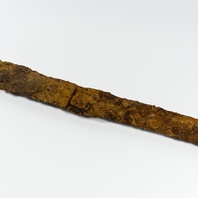
Viking Objects
Sword (1989-59/7113)
This Viking Age sword was found in Grave 511 at Repton where the invading Viking Great Army had their winter camp in 873/4. When it was found, the sword had traces of a wooden scabbard attached to the rusted blade. Analysis showed that the scabbard was lined with fleece and covered in leather. The grip was wooden and covered in a woollen textile.
Read More
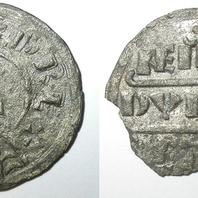
Viking Objects
Coin of Alfred the Great (1989-58/3381)
This silver penny from the mass grave at Repton was minted by a moneyer called Dudwine in Canterbury for Alfred the Great. Alfred was King of Wessex from 871 to 899 and spent most of his reign fighting off Viking invasions. He won a decisive victory at the Battle of Edington in 878 which resulted in a peace with the Vikings and the creation of the Danelaw. Minting coins was a way of controlling the means of exchange within a kingdom and which created a more easily administered standardized system of trade. Moreover, the coins themselves were often used as propaganda, portaying symbols and statements that gave off a desired message. The Vikings later used the minting of coins to legitimize their own rule.
Read More
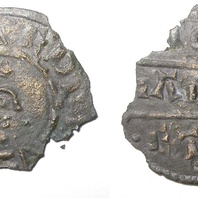
Viking Objects
Coin of Aethelred (1989-58/3395)
A silver penny of Aethelred I of Wessex was found in the mass grave at Repton and minted by a moneyer apparently called Liabinc. The location of minting is unknown. Aethelred I was King of Wessex from 865 until his death in 871. Aethelred’s reign coincided with the arrival of the Viking Great Heathen Army in England and he fought them with little success during their invasion of Wessex which began in 870. After his death, he was succeeded by his youngest brother, Alfred the Great, who carried on the war with the Vikings. Minting coins was a way of controlling the means of exchange within a kingdom and which created a more easily administered standardized system of trade. Moreover, the coins themselves were often used as propaganda, portraying symbols and statements that gave off a desired message. The Vikings later used the minting of coins to legitimize their own rule.
Read More

Viking Talks
Repton and the Legacy of the Viking Great Army
In 873 the Viking Great Army attacked the monastery in Repton, forcing the Mercian king to flee the country and installing a puppet king in his place. 1100 years later, excavations uncovered a large defensive ditch, several distinctly Scandinavian graves, and a mound containing the remains of nearly 300 people. This talk presents new scientific analyses of the burials at Repton, bringing us closer to uncovering the identities of those buried there. In addition, results of new excavations have provided a better understanding of the Viking winter camp. Put together, this new evidence allows for a reassessment of the Viking presence in Repton and the legacy the Great Army left behind. Cat Jarman Wednesday 28 February 2018
Read More

Blog Post
Winter Camps in the East Midlands: Location and Layout
Our knowledge of the Viking Great Army’s movments during its campaigns in England is provided by entries in the Anglo-Saxon Chronicle, a compilation of annalistic entries that describe events in a particular year. Despite some drawbacks to using the chronicle as a source, it does provide a roadmap for where the Vikings stopped for the winter. In fact, these were termed wintersetl by the compilers of the chronicle otherwise known as winter camps. Two of the winter camps mentioned in the Anglo-Saxon Chronicle are under current investigation, Repton and Torksey. © P L Chadwick, via Geograph, CC BY-SA 2.0 Both winter camps are located along a river which would have provided the Viking inhabitants with vital transportation links required in most raiding or trading activities. It would also seem likely that the waterways were selected in order to provide a natural defensive element to the settlement, usually alongside another natural feature such as a raised promontory or a marsh, or an easy means of escape if the settlement was overwhelmed. In addition, the winter camps seem to be placed in relation to recently captured territory which makes sense for force out on campaign. Viking invaders took Repton and immediately constructed a D-shaped wall using the pre-existing church as a gatehouse. The remnants of this wall were discovered in the 1970s and 1980s in the form of a V-shaped ditch, calculated to have been about 8m wide and 4m deep, cutting through the earlier Anglo-Saxon monastic burials (Biddle and Kjølbye-Biddle 2001, 57, 59; Jarman 2018a, 29). The 1979 excavations revealed four successive ditches; the V-shaped ditch with a flat narrow bottom was the earliest and was backfilled shortly after being dug (Biddle and Kjølbye-Biddle 2001, 58). The ditches have been dated to between the Group 2 Middle Anglo-Saxon and Group 3 Post-Viking burials, which fits with late ninth-century ‘Great Army’ occupation (Biddle and Kjølbye-Biddle 2001, 59). A Viking sword found at Repton, Derbyshire. (c) Derby Museums 2019 Unlike Repton, in Torksey Vikings only utilized natural defences, such as the river Trent and the wet marshy ground, which turned the settlement into an island (Hadley and Richards 2016, 32; Raffield 2016, 313). Despite not having any walls or ditches, it is likely that the ‘Great Army’ would have found the water and marsh defence sufficient in light of their recent peace with Mercia (Raffield 2016, 323). A quarter of an imitation Carolingian gold solidus found near Torksey, Lincolnshire. © The Fitzwilliam Museum, Cambridge In terms of buildings there is a general lack of evidence for permanent structures at both Torksey and Repton. It is unclear whether this is due to poor preservation, need for more archaeological investigation, or that they truly did not exist. The use of Repton, Torksey, and the other wintersetl as army bases during campaigning probably explains the lack of permanent dwellings and workshops from their foundation but does not explain why none were built throughout the rest of their occupation when the army left. The lack of urban planning and systems of streets and plots likely has to do with either a lack of refinement in terms of the methodology and ideas behind settlement foundation which requires more experience over time, the motivations and needs surrounding the foundation of a settlement, or even a combination of both. As mentioned above, the wintersetl in England were created, primarily, to house a military force on campaign, which moved on very quickly after the settlement was established. Therefore, it would not make sense to spend time and resources developing a systematic layout nor to begin the time-consuming process of building permanent structures. References: Biddle, Martin, and Birthe Kjølbye-Biddle. 2001. ‘Repton and the “Great Heathen Army”, 873–4’. In Vikings and the Danelaw: Select Papers from the Proceedings of the Thirteenth Viking Congress, edited by James Graham-Campbell, Richard Hall, Judith Jesch, and David Parsons, 45–96. Oxford: Oxbow Books. Hadley, Dawn, and Julian Richards. 2016. ‘The Viking Winter Camp and Anglo-Scandinavian Town at Torksey, Lincolnshire – the Landscape Context’. The Antiquaries Journal, no. 96: 23–67. Raffield, Ben. 2016. ‘Bands of Brothers: A Re-Appraisal of the Viking Great Army and Its Implications for the Scandinavian Colonization of England’. Early Medieval Europe 24 (3): 308–37.
